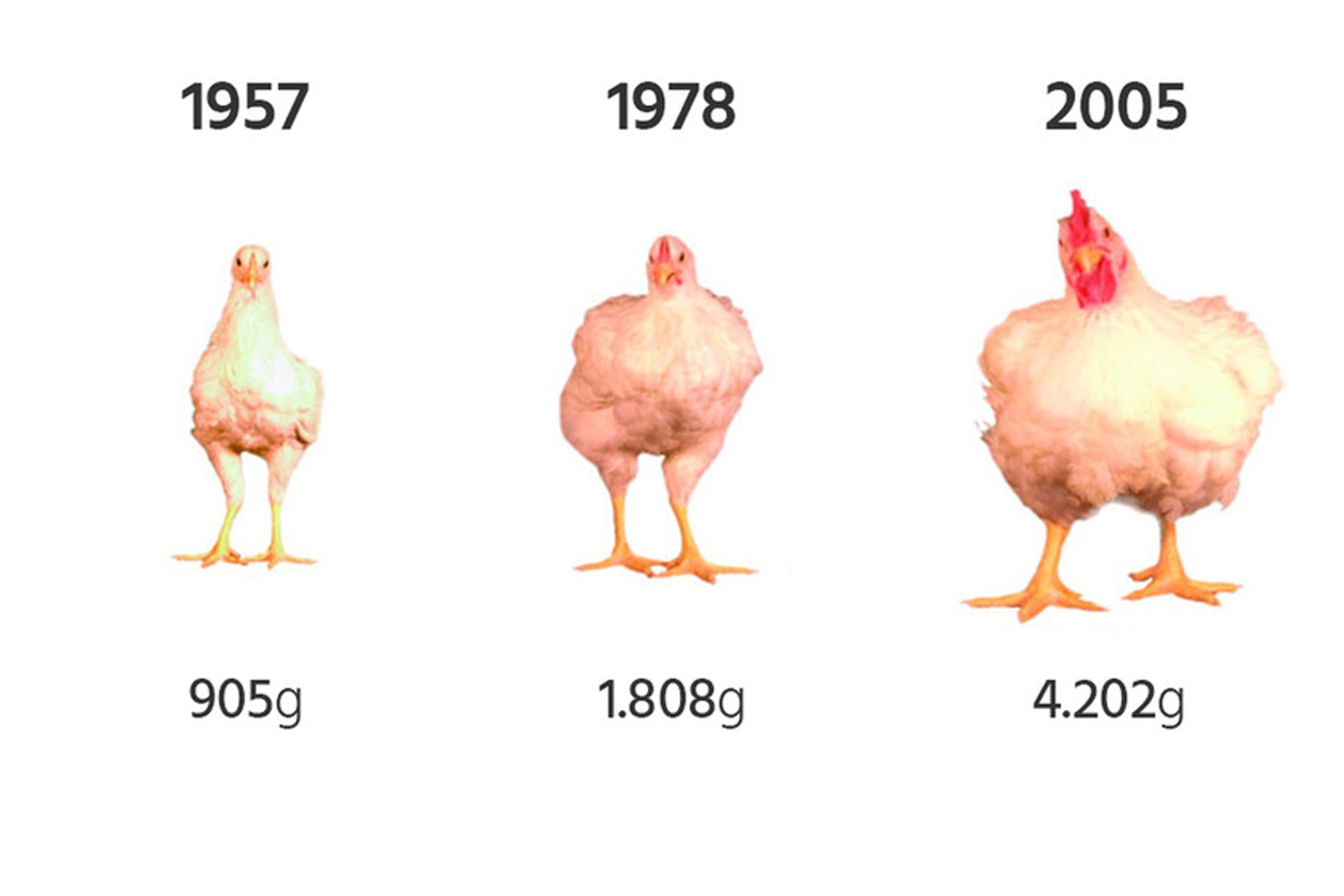
Why Do Chickens Grow Faster Than Before? A Comprehensive Analysis of Modern Poultry Farming
Poultry farming has undergone a radical transformation in recent decades, and one of the most notable changes is the speed at which chickens reach market weight. While in the 1950s, a chicken took around 16 weeks to reach 1.5 kg, today it can be achieved in less than 6 weeks.
ANIMAL PRODUCTION
3/3/20255 min read
Poultry farming has undergone a radical transformation in recent decades, and one of the most notable changes is the speed at which chickens reach market weight. While in the 1950s, a chicken took around 16 weeks to reach 1.5 kg, today it can be achieved in less than 6 weeks. This phenomenon has sparked both admiration and controversy, and its explanation lies in a combination of factors, including genetics, nutrition, management, technological advancements, and market demands. However, this rapid growth also raises ethical, environmental, and animal welfare challenges that warrant deep reflection.
1. Genetic Improvement: The Foundation of Accelerated Growth
One of the key pillars of accelerated chicken growth is selective breeding. Through breeding programs, geneticists have developed highly specialized broiler lines, such as the Cobb 500 and Ross 308, which grow faster and with greater feed efficiency. These modern breeds have been designed to prioritize muscle development, particularly in the breast, which is the most sought-after part by consumers.
However, this focus on rapid growth has had unintended consequences. Studies from the University of Bristol (2018) reveal that up to 30% of modern broilers develop lameness due to the disproportionate weight of their breast, which puts pressure on their legs. Additionally, their cardiovascular and skeletal systems do not always develop at the same pace as their muscle mass, leading to health issues such as heart failure or sudden death syndrome.
In response to these concerns, Europe has promoted the use of slower-growing breeds, such as the Hubbard JA757, which takes 10 days longer to reach market weight but has a 50% lower mortality rate and better quality of life.
2. Optimized Nutrition: The Fuel for Growth
Nutrition plays a crucial role in chicken growth. In recent decades, highly specialized diets have been developed to meet the specific nutritional needs of birds at each stage of their life. These diets are formulated with a precise combination of proteins, amino acids, vitamins, minerals, and other essential nutrients that promote rapid and healthy growth.
Additionally, advances in nutritional science have improved nutrient digestibility and absorption. For example, the inclusion of enzymes in feed has enhanced nutrient availability, reducing the amount of feed needed to achieve the desired weight. According to the FAO, in 1970, 3 kg of feed were required to produce 1 kg of chicken, whereas today only 1.6 kg are needed.
3. Management and Rearing Conditions: A Controlled Environment
Modern farms are equipped with automated climate control systems that maintain optimal temperature, humidity, and ventilation for chicken growth. These controlled conditions reduce stress in the birds and allow them to dedicate more energy to their development.
The use of technologies such as artificial lighting regulates light and dark cycles, influencing feeding behavior and growth. Furthermore, automation and big data have revolutionized the industry, enabling real-time monitoring of weight, temperature, and feed consumption, allowing adjustments to rearing conditions to maximize efficiency.
4. Environmental Impact of Intensive Production
The accelerated rearing of chickens has helped meet the growing global demand for protein but has also generated significant environmental impacts. According to a report by the Food and Agriculture Organization (FAO), poultry farming accounts for 8% of global greenhouse gas emissions associated with meat production. Additionally, the intensive use of resources such as water and grains to feed chickens has raised concerns about long-term sustainability.
However, the industry has begun adopting more sustainable practices, such as diets based on insects or algae, which reduce reliance on traditional crops. Renewable energy systems are also being implemented on farms to minimize their carbon footprint.
5. Consumer Perspective and Trends
The accelerated growth of chickens has made poultry meat one of the most affordable and accessible proteins worldwide. However, consumers are increasingly concerned about animal welfare and the quality of the food they consume. Recent surveys show that 60% of consumers in Europe and North America are willing to pay more for chickens raised in free-range or antibiotic-free systems.
In response to this demand, many companies have adopted certifications such as "Certified Humane" or "Global Animal Partnership," which guarantee higher animal welfare standards. Additionally, the "Slow Growth" movement in Europe promotes the use of slower-growing breeds, which, although they take longer to reach market weight, offer a better quality of life for the birds.
6. Emerging Technologies and the Future of Poultry Farming
Poultry farming is not immune to the technological revolution. Innovations such as lab-grown meat and plant-based proteins are gaining ground as sustainable alternatives to traditional production. Although these technologies are still in development, they could transform the industry in the coming decades.
Moreover, automation and the use of artificial intelligence are optimizing rearing processes, from incubation to processing, reducing costs, and improving efficiency.
7. Ethics and Animal Welfare: A Necessary Debate
The rapid growth of chickens has sparked intense debate about animal welfare. Organizations like Compassion in World Farming have criticized the overcrowded conditions and health issues associated with intensive farming. In response, several countries have implemented stricter regulations, such as the ban on battery cages in the European Union.
The industry faces the challenge of balancing production efficiency with animal welfare, ensuring that chickens have an adequate quality of life during their short lifespan.
8. Myths and Realities About Accelerated Chicken Growth
The rapid growth of chickens has given rise to numerous myths and misconceptions, many of which are perpetuated by misinformation or lack of context. Below, we debunk some of the most common myths:
Myth 1: "Chickens grow fast because they are injected with hormones"
Reality: This is one of the most widespread myths, but it is entirely false. The use of hormones in poultry farming is prohibited in most countries, including the United States and the European Union. Rapid growth is primarily due to selective breeding and optimized nutrition, not hormone administration. In fact, injecting hormones would be economically unfeasible and technically unnecessary, given the success of breeding programs.
Myth 2: "Broiler chickens are genetically modified"
Reality: Modern broiler chickens are not genetically modified (GMOs) but are the result of decades of traditional selective breeding. Geneticists have systematically crossed birds with the most desirable traits, such as higher feed-to-muscle conversion, to create highly efficient breeds. Genetic modification, which involves inserting genes from other species, is not used in commercial chicken production.
Myth 3: "Rapid-growth chickens are unhealthy to eat"
Reality: Modern broiler chickens are safe for consumption and meet food safety standards set by health authorities. However, their rapid growth can lead to animal welfare issues, such as lameness or heart problems, which has raised ethical concerns. Nonetheless, these issues do not affect the food safety of the final product.
Myth 4: "Traditionally raised chickens are more nutritious"
Reality: There is no scientific evidence to suggest that traditionally raised chickens (in free-range or extensive systems) are more nutritious than those raised in intensive systems. Both types of chickens provide similar nutritional value in terms of protein, vitamins, and minerals. The main differences lie in animal welfare and environmental impact, not in nutritional quality.
Myth 5: "Broiler chickens cannot walk due to their size"
Reality: While some broiler chickens may experience difficulty walking due to their rapid muscle growth, this is not universal. The issue is more related to rearing conditions and the specific genetics of certain breeds. In well-managed systems with adequate space, many chickens can move without problems.
Myth 6: "Rapid-growth chicken meat tastes different"
Reality: The taste of chicken meat depends more on factors such as diet, age at slaughter, and cooking methods than on growth speed. However, some consumers argue that slower-growing, free-range chickens may have a slightly different texture and flavor due to their increased physical activity and varied diet.
Myth 7: "All broiler chickens live in deplorable conditions"
Reality: While some intensive systems have been criticized for overcrowding, not all farms operate the same way. Many companies have adopted higher animal welfare standards, such as free-range systems or certifications like "Certified Humane." Additionally, regulations in many countries require minimum standards for space, ventilation, and cleanliness.
Conclusion: Balancing Efficiency and Responsibility
The rapid growth of chickens is the result of decades of research, innovation, and continuous improvement in genetics, nutrition, management, and animal health. This phenomenon has revolutionized food production, making chicken meat one of the most accessible proteins worldwide.
However, this success is not without challenges. The industry must balance production efficiency with animal welfare, environmental sustainability, and consumer demands. Only through a comprehensive and responsible approach can we ensure that poultry farming remains a sustainable source of protein for future generations.
AgroPetEd
Information about animals and agricultural practices
© 2025. All rights reserved.
